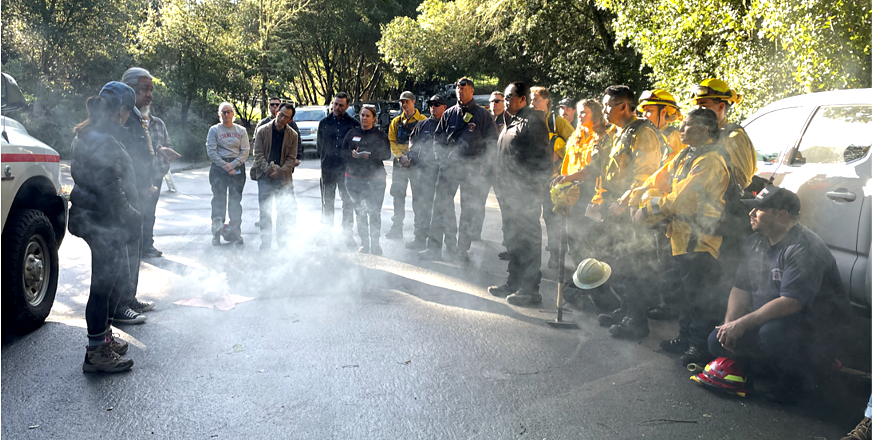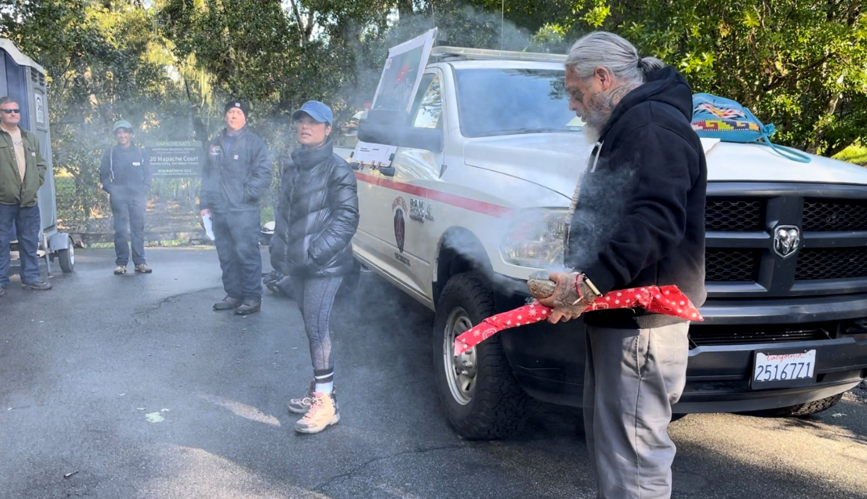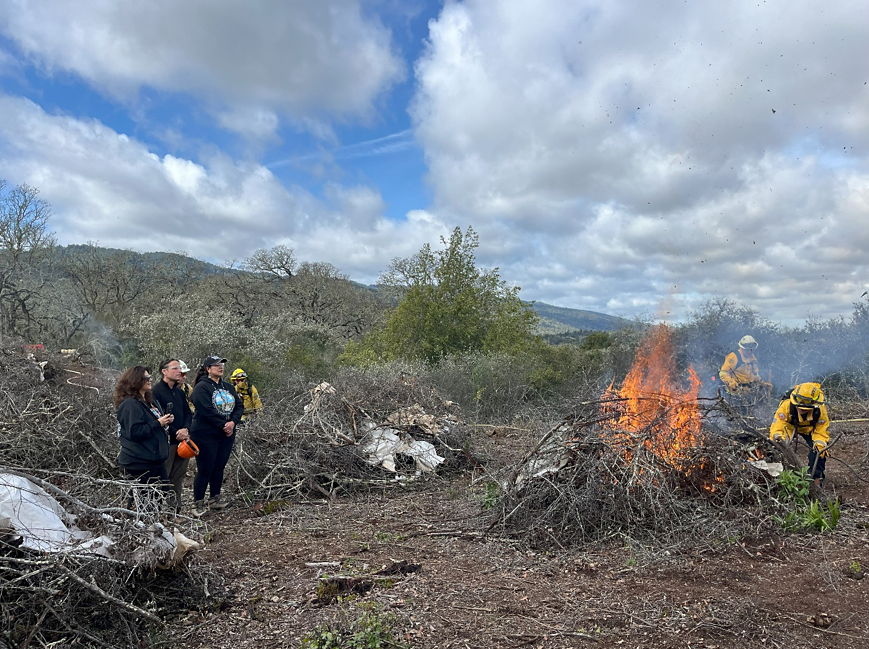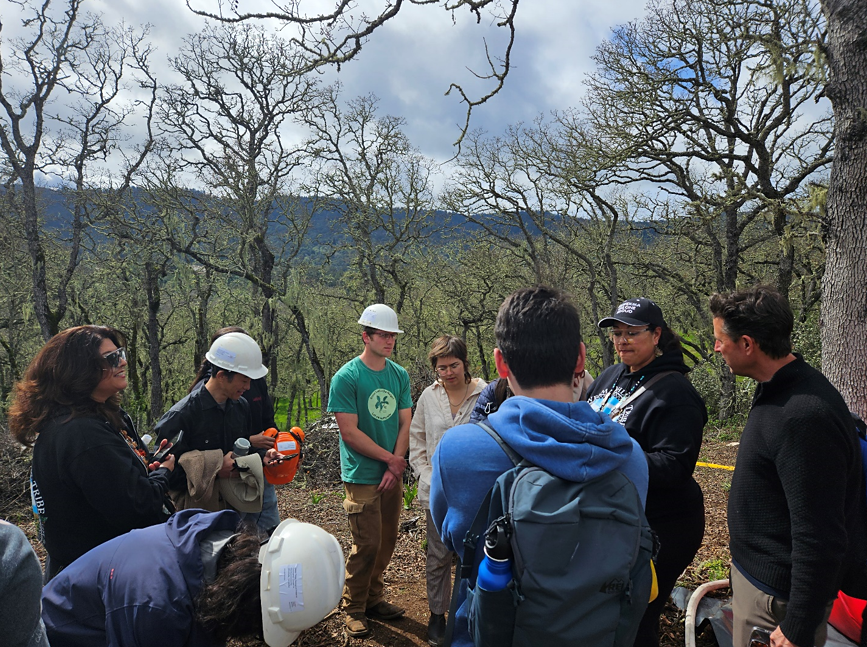Both eyes sparkle at JRBP'O'O’s intentional fire

We were thrilled to have members of the Muwekma Ohlone Tribe of the San Francisco Bay Area participate in the initiation of pile burning at Jasper Ridge Biological Preserve - 'Ootchamin 'Ooyakma on Monday, March 4, 2024.
The Tribal members’ interaction with students, faculty, staff, and the fire crew that day inspired us to start taking new steps toward two-eyed seeing in research, education, and stewardship at JRBP'O'O, guided by both Indigenous and Western science.
Disconnect, reconnect, and new ways to collaborate
We were fortunate to have Charlene Nijmeh, the chairwoman of the Muwekma Ohlone Tribe, join us along with Joseph (Joey) Torres, a Tribal member, at the start of the day. During the morning briefing led by the Burn Boss Phil Dye, the chairwoman told us about the significance of their land and the Tribe’s connection to it.
“This is a very important, significant event for us to be a part of today. Our people have been displaced since the first contact, when we were forced into the three Bay Area missions, Mission San Francisco, Santa Clara, and San Jose,” the chairwoman said. “We were disconnected from our land for a very long time, so this is the first time [in a long time], with the support from Stanford University, that has brought us out here.” The intentional use of fire on their ancestral homeland is an essential element of the Tribe’s traditional culture.

Charlene Nijmeh (center) and Joey Torres (right) speaking at the morning briefing
The chairwoman then went on to generously say, “we have had a 35-year, long-standing relationship with Stanford. They have always been very welcoming for our Tribe, to welcome us to be partners, whatever that looks like on their campus, and now on the land. They want to help us connect and learn about ecology, and we greatly appreciate it.”
These remarks from the chairwoman were followed by Joey saying a few words about their ancestors and the Ohlone villages that existed within and around JRBP'O'O. He then offered a song of protection in the native Chochenyo language, to pray that we were all well protected as we began the burning. While Charlene and Joey were at the burn site, Laura Jones, the University Archaeologist and a long-term liaison between Stanford and the Tribe, joined us to see the burn and greeted the Tribal members.
As we looked at the piles together, Charlene expressed interest in engaging in more activities at JRBP'O'O, involving both adult and youth members of the Tribe. Providing opportunities for outdoor education, particularly for Tribal youth, is one of the most impactful ways in which JRBP'O'O can foster a long-term partnership with the Tribe. This partnership would not only benefit the youth, but also provide a solid moral foundation on which to base all research and education efforts made at JRBP'O'O. JRBP'O'O staff is now coordinating with the Tribe to explore what is possible to reconnect us all—including the next generation of Tribal youth—with the local land.
Students’ conversation with Tribal members
Later in the day, two Tribal members, Monica Arellano (former vice chairwoman) and Gloria Arellano-Gómez (former councilmember), came to the burn site. They offered a prayer in the Chochenyo language, to thank the Creator, in front of a burn pile as the fire crew lit the fire on that pile. Around the same time, Mike Wilcox, Senior Lecturer in Native American Studies, and about half a dozen undergraduate and graduate students from his native plants garden class also came to witness the pile burn. They were able to be there when Monica and Gloria said the prayer.

Monica Arellano (left) and Gloria Arellano-Gómez (right) saying a prayer, alongside Mike Wilcox (center), as the fire crew light a burn pile
The prayer was followed by a spontaneous conversation between Monica and Gloria and the students. The conversation touched on a variety of topics. Students asked how to pronounce 'Ootchamin 'Ooyakma (hear Monica say it here) and discussed why revitalizing the Chochenyo language is so important. They also talked about how they might be able to learn more about the Indigenous culture and asked how they could help the Tribe realize what they hope to accomplish. Lasting more than an hour, this conversation was characterized by a respectful, forward-looking tone from both sides.
One of the things Monica and Gloria generously offered was to provide Chochenyo names of trails and other features within JRBP'O'O. In addition, they suggested to the students the possibility of working on an augmented reality tour project, modeling after the recent success at Santa Clara University, in which Isabella Gomez, Gloria’s daughter, was involved. Student projects like this would contribute to accomplishing the education mission of JRBP'O'O.

Stanford students conversing with Monica Arellano and Gloria Arellano-Gómez
Inspired by this student-Tribe conversation, JRBP'O'O staff members later discussed the possibility of including the Tribe in future land stewardship activities. The staff would like to learn from the Tribe how they might like to use the burned areas for traditional cultural practices, and collaborate with them accordingly to support these efforts.
A new beginning of two-eyed seeing at JRBP'O'O
For two-eyed seeing to make a real impact, it needs to be grounded in reciprocal collaboration between Indigenous and Western approaches. The mutual respect that was apparent at the pile burn gave a sense of optimism toward that goal. When guided by authentic two-eyed seeing, research and education at JRBP'O'O can hope to shed light on how to sustainably steward the land through co-governance. We at JRBP'O'O are grateful to the Muwekma Ohlone Tribe for their generosity in guiding us and working with our students, faculty, docents, and staff members.
We also thank the Burn Boss, Phil Dye, and the fire crew for their support. Throughout the day, they were very accommodating to everyone who came to witness the fire. Phil kindly answered many questions that the students and the Tribal members asked.
By Tadashi Fukami



